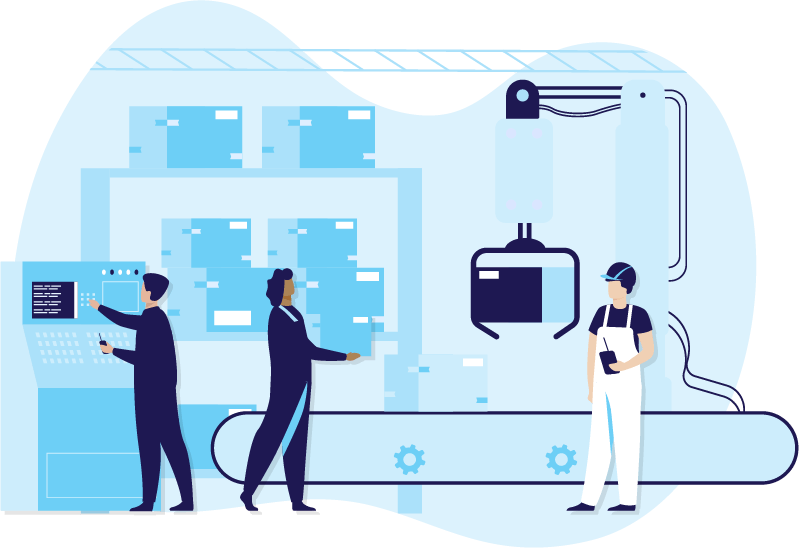Working from home is not new. Humans have actually spent more time working remotely than in offices. The growth of remote work over the last several years is a reflection of our past… well, in a way. It’s a return to an earlier way of working. From humans earliest inventions like the wheel and the printing press to more modern achievements like mobile devices and messaging apps, technology has and continues to play a significant role on where and how we work.

Let’s travel back in time and discover how almost all work was remote at one point or another.
From Hunter Gatherers to Digital Natives
Early Life to the Middle Ages
Early humans blurred the lines between work life and home life. The work/home environment was a day-to-day feature of life for hunter-gatherers. They foraged for wild plants, fished in nearby lakes and rivers and hunted local fauna. They sorted and prepared their food and fashioned clothing for protection, all in the spaces they lived. Once agriculture came along a mere 12,000 years ago, society shifted but humans continued working from their residences.
In the middle ages, hand tools and mills were considered modern technology. Bakers, seamstresses, shoemakers, potters, weavers, carpenters, brewers and blacksmiths would set up shop at their place of living. They sold their goods or applied their skills during the day and closed up shop to sleep not far from the tools of their trade. Having their place of work intertwined with their place of living made life easier.
The Industrial Revolution
If you’re looking for an era to blame for the 9-5 work model, look no further than the Industrial Revolution. During this time, people began working in factories making things like clothing, shoes, household items and tools. Factories produced items faster and cheaper and factory work brought profound changes to the way people worked. Unlike the Middle Ages, the Industrial Revolution brought big machinery that needed to be housed and maintained in factories. The way people worked started to significantly shift.

The Industrial Revolution set up the work-outside-the-home model that many employers still follow today. This model means working a set schedule in an employer-provided environment, (factory or office) with employer-provided tools or equipment.
Some people, many of them women, continued working from home in jobs like making and repairing clothing and selling food to factory workers. That changed after World War II.
World War II
It’s no secret the U.S. economy was shaky pre-World War II. After the stock market crash and the Great Depression, the mobilization effort during World War II put Americans back to work. Many of these workers were women. After the war, these women continued to work outside the home. Factories met the needs of consumers who had saved their money during war-time.
For more than three years, Americans pinched pennies. In “A Consumer’s Republic: The Politics of Mass Consumption in Postwar America,” Lizabeth Cohen wrote that by 1945, Americans were saving around 21 percent of their disposable income, compared to only 3 percent in the 1920s.
American consumers were eager to spend their money on everything from large items like homes, cars and furniture to clothing, shoes and anything else factories could produce. This boom created more jobs outside of the home and Americans flocked to meet demand. But as technology evolved and manufacturing jobs slowed, work again shifted to a home-based model.
The Internet Age
The Internet Age brought smaller, more affordable devices and access to connectivity, making it easier for people to be mobile. Computers and the internet paved the way for modern day remote work. In the late 1990s, more people started buying personal computers, and even more were connecting their homes to the internet. In the early 2000s, a few U.S. companies allowed their employees to work from home. They saw employees who were more productive, had a better quality of life and cut expenses and commuting time when telecommuting. Some of the same benefits we see with remote workers today.
Then wireless internet and public WiFi turned another page. Remote employees weren’t tethered to a physical location. Dial-up internet became a bad memory with the introduction of WiFi.
According to Gallup, 4.7 million people currently work from home in the U.S. This figure has grown 150 percent in the last 13 years. The future of remote work continues to grow, and the technology to support remote workers is only getting better.
Whether working from a home office, on a laptop in a van, or from a smartphone, WiFi gives employees access to cloud-based platforms. These applications help them do everything they would do in an office. Now, virtual employees work all hours of the day and can stay in touch with their coworkers from all over the world.
Team collaboration tools like Microsoft Teams and Webex combine the virtual office and watercooler in one. Anyone on the team can check in with other employees — connecting is as easy as sending a text message. Plus, video meetings ensure no one remains a stranger behind their computer screen. Many teams also use project management apps like Trello to create a digital to-do list.
Remote Work For the Ages
So, the saying rings true. History repeats itself. Remote workers of the past may not have a lot in common with remote workers of the present. But history shows that remote work has been around since the dawn of the workforce. And because the pros outweigh the cons, remote work shows no signs of fading away. Combining work space and living space is an easy way for people to manage resources, be productive at various times of day and take care of loved ones.

Thanks to developments in technology, it’s easier for employees to collaborate from home and meet project deadlines. Plus, employers now have a larger pool of talent to search for that hero candidate. So get ready. Employers who promote remote work should create environments where remote employees can thrive.
Who can say what the future holds? One day our grandchildren may be amazed when we tell them we commuted into an office.





